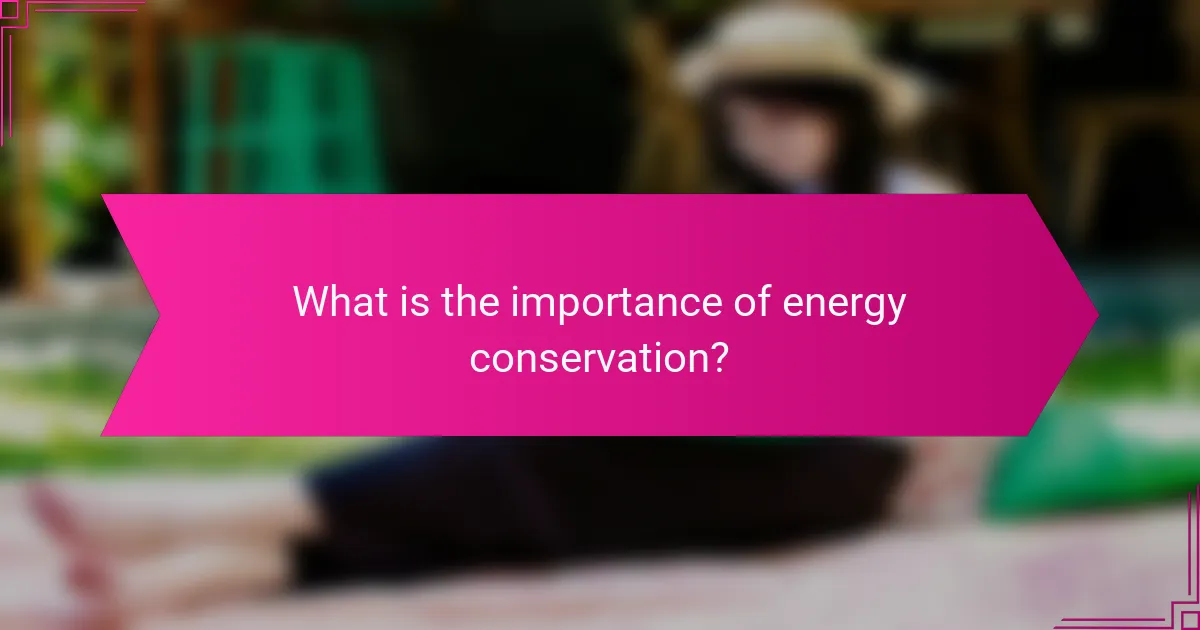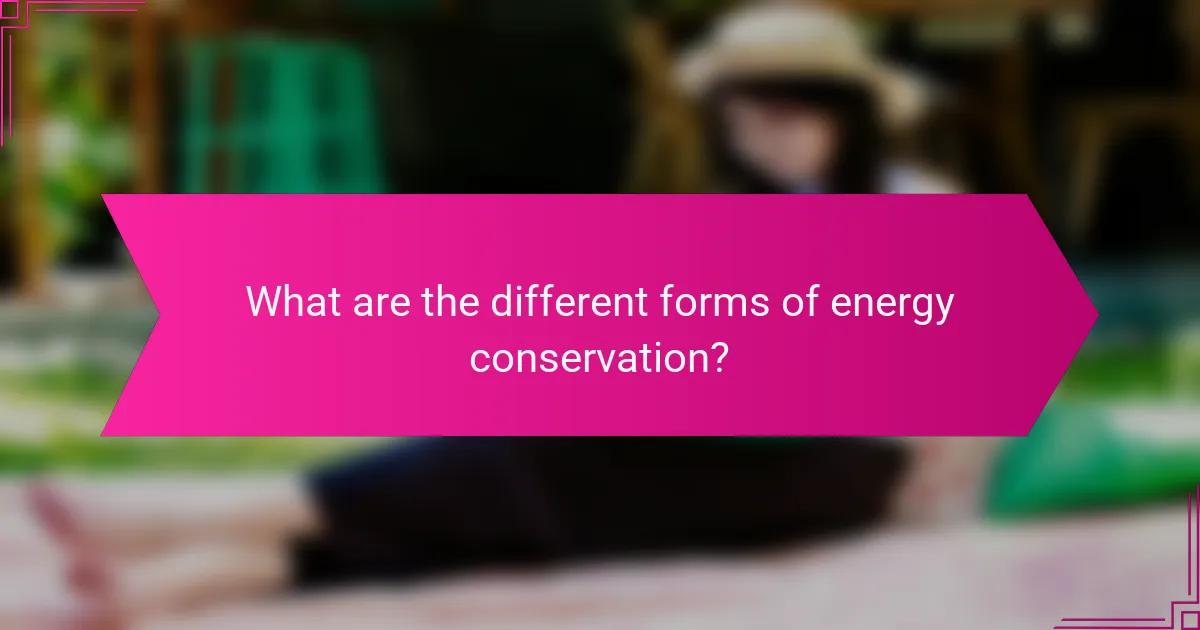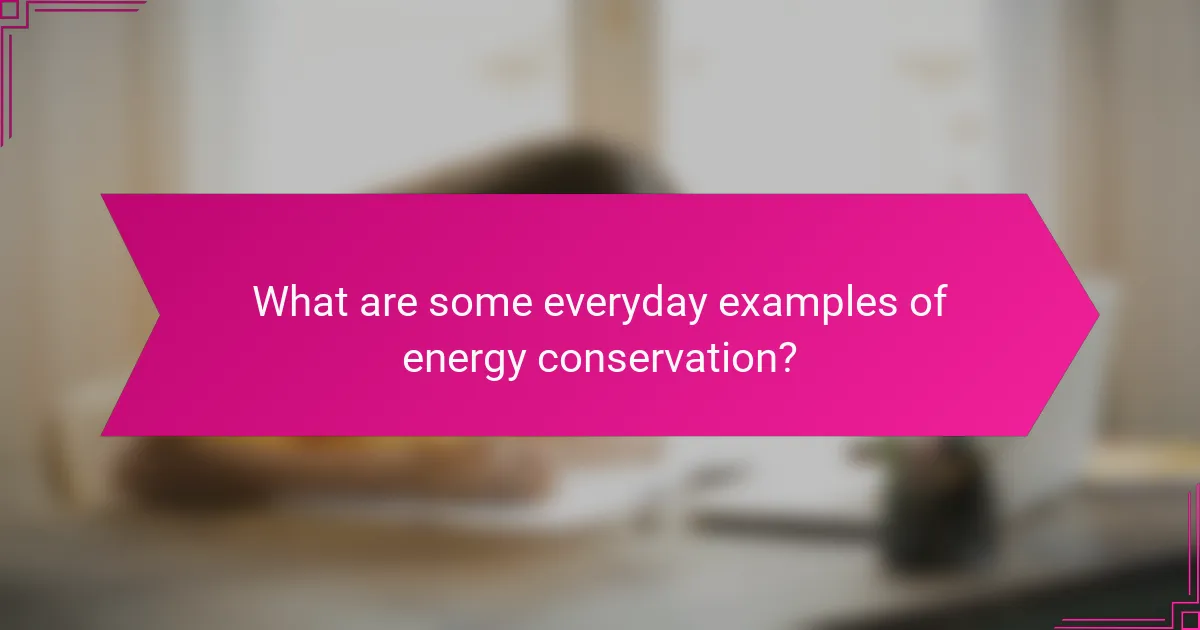Energy conservation is a critical practice for sustainable development, focusing on reducing energy consumption, improving energy efficiency, and utilizing renewable energy sources. This article outlines the importance of energy conservation in lowering greenhouse gas emissions, decreasing reliance on non-renewable resources, and providing long-term economic benefits. Key principles include simple actions such as turning off lights, using energy-efficient appliances, and harnessing renewable energy like solar and wind power. By implementing these strategies, individuals and businesses can significantly reduce energy costs and enhance energy security, ultimately contributing to environmental protection and economic stability.

What is the importance of energy conservation?
Energy conservation is crucial for sustainable development. It reduces environmental impact by lowering greenhouse gas emissions. Conserving energy also decreases reliance on non-renewable resources. This leads to long-term economic benefits through reduced energy costs. According to the U.S. Department of Energy, energy efficiency can save consumers and businesses over $500 billion annually. Additionally, energy conservation enhances energy security by reducing demand and stabilizing energy prices. Implementing energy-saving measures can result in a significant decrease in energy consumption. Thus, energy conservation plays a vital role in protecting the planet and promoting economic stability.
Why is energy conservation crucial for the environment?
Energy conservation is crucial for the environment because it reduces greenhouse gas emissions. These emissions contribute to climate change and global warming. By conserving energy, we decrease the demand for fossil fuels. Fossil fuel extraction and consumption are significant sources of pollution. According to the U.S. Environmental Protection Agency, energy production accounts for about 25% of total greenhouse gas emissions. Additionally, energy conservation helps preserve natural resources. This includes reducing the need for mining and drilling, which can harm ecosystems. Efficient energy use also leads to lower energy costs for consumers. Thus, energy conservation plays a vital role in protecting the environment and promoting sustainability.
How does energy conservation impact climate change?
Energy conservation significantly impacts climate change by reducing greenhouse gas emissions. When individuals and organizations conserve energy, they decrease the demand for fossil fuels. Fossil fuel combustion is a major source of carbon dioxide and other greenhouse gases. According to the U.S. Environmental Protection Agency, energy efficiency measures can reduce emissions by 30% or more. This reduction helps mitigate global warming and its associated effects. Additionally, conserving energy lowers overall energy consumption, leading to less pollution. The International Energy Agency reports that energy efficiency could help limit global temperature rise to 1.5 degrees Celsius. Thus, energy conservation plays a crucial role in combating climate change.
What role does energy conservation play in resource management?
Energy conservation plays a crucial role in resource management. It reduces the demand for energy resources, leading to decreased extraction and consumption. By conserving energy, organizations and individuals can lower operational costs. This practice also minimizes environmental impacts associated with energy production. For instance, the U.S. Department of Energy states that energy efficiency can reduce greenhouse gas emissions significantly. Efficient energy use contributes to sustainability by prolonging the availability of resources. Overall, energy conservation is essential for effective resource management and environmental protection.
How does energy conservation benefit individuals and communities?
Energy conservation benefits individuals and communities by reducing utility costs and environmental impact. Lower energy consumption leads to decreased electricity bills for households. This financial relief allows individuals to allocate funds to other essential needs. Communities benefit from reduced demand on power plants, leading to lower greenhouse gas emissions. According to the U.S. Environmental Protection Agency, energy conservation can reduce carbon dioxide emissions significantly. Additionally, conserving energy helps to prolong the lifespan of natural resources. This ensures sustainable energy availability for future generations. Overall, energy conservation fosters economic savings and environmental health for individuals and communities alike.
What are the financial savings associated with energy conservation?
Energy conservation leads to significant financial savings for households and businesses. Reducing energy consumption directly lowers utility bills. For example, the U.S. Department of Energy states that energy-efficient upgrades can save homeowners 10-50% on their energy costs. Additionally, implementing energy-saving measures can qualify for tax credits and rebates. These incentives further enhance financial savings. Businesses can also benefit from reduced operational costs, which can lead to increased profitability. According to the American Council for an Energy-Efficient Economy, energy efficiency measures can yield a return on investment of 2-4 times the initial costs. Overall, energy conservation is a financially beneficial practice for both individual consumers and organizations.
How does energy conservation enhance quality of life?
Energy conservation enhances quality of life by reducing utility costs and minimizing environmental impact. Lower energy bills allow individuals and families to allocate funds to other essential needs. This financial relief can lead to improved mental well-being and reduced stress levels. Additionally, energy conservation contributes to a healthier environment. It decreases greenhouse gas emissions, which are linked to climate change and public health issues. According to the U.S. Environmental Protection Agency, energy efficiency measures can reduce energy consumption by 25-30%. This reduction leads to cleaner air and water, promoting overall public health. Furthermore, sustainable energy practices can create job opportunities in green technology sectors. These benefits collectively improve living conditions and foster a more sustainable future.

What are the key principles of energy conservation?
The key principles of energy conservation include reducing energy consumption, improving energy efficiency, and utilizing renewable energy sources. Reducing energy consumption involves minimizing unnecessary usage. This can be achieved by turning off lights and unplugging devices. Improving energy efficiency means using technology that requires less energy for the same output. For example, LED bulbs use significantly less energy than traditional incandescent bulbs. Utilizing renewable energy sources involves harnessing energy from sustainable resources such as solar, wind, and hydro. According to the U.S. Department of Energy, adopting these principles can lead to significant reductions in energy bills and environmental impact.
What fundamental concepts govern energy conservation?
Energy conservation is governed by the law of conservation of energy. This principle states that energy cannot be created or destroyed. It can only change forms, such as from potential to kinetic energy. For example, when a ball rolls down a hill, its potential energy converts to kinetic energy. The total energy in a closed system remains constant. This concept is foundational in physics and applies to all energy transformations. Experimental evidence supports the law, as seen in countless scientific experiments.
How do the laws of thermodynamics relate to energy conservation?
The laws of thermodynamics establish fundamental principles that govern energy conservation. The first law, known as the law of energy conservation, states that energy cannot be created or destroyed. It can only change forms, such as from kinetic to potential energy. This principle underscores that the total energy in a closed system remains constant.
The second law of thermodynamics introduces the concept of entropy. It states that energy transformations are not 100% efficient. Some energy is always lost as waste heat, which affects the usable energy in a system. This means that while energy is conserved in total, its quality and availability for work can diminish.
These laws collectively highlight that energy conservation is not just about quantity but also about the quality and efficiency of energy use. For example, in mechanical systems, some energy is transformed into heat due to friction, reducing the amount available for useful work. Thus, understanding these laws is essential for improving energy efficiency and promoting conservation practices.
What is the relationship between energy efficiency and conservation?
Energy efficiency and conservation are closely related concepts in managing energy use. Energy efficiency refers to using less energy to provide the same service. For example, LED light bulbs use less electricity than traditional incandescent bulbs while producing the same amount of light. Conservation, on the other hand, involves reducing energy consumption through behavioral changes, such as turning off lights when not in use.
Both strategies aim to reduce overall energy demand. Implementing energy-efficient technologies can lead to significant energy savings. According to the U.S. Department of Energy, energy efficiency improvements can reduce energy consumption by up to 30%. Conservation efforts, such as adjusting thermostat settings, can complement these improvements. Together, they contribute to lower energy costs and reduced environmental impact.
How can behavioral changes contribute to energy conservation?
Behavioral changes can significantly contribute to energy conservation by reducing energy consumption in daily activities. Simple actions, like turning off lights when leaving a room, can lead to substantial energy savings. According to the U.S. Department of Energy, such practices can save up to 10% on energy bills. Additionally, using energy-efficient appliances can further decrease usage. The Energy Star program reports that these appliances use 10-50% less energy than standard models. Furthermore, adopting habits like carpooling or using public transport reduces fuel consumption, which contributes to lower overall energy demand. Research from the American Council for an Energy-Efficient Economy shows that behavioral programs can reduce energy use by 5-15%. This evidence illustrates how individual choices directly impact energy conservation efforts.
What habits can individuals adopt to save energy?
Individuals can adopt several habits to save energy. Turning off lights when leaving a room reduces electricity use. Using energy-efficient appliances can lower energy consumption significantly. Setting the thermostat a few degrees lower in winter and higher in summer conserves heating and cooling energy. Unplugging devices not in use prevents phantom energy drain. Utilizing natural light during the day decreases reliance on artificial lighting. Washing clothes in cold water saves energy compared to hot water. Air-drying laundry instead of using a dryer also conserves energy. Regularly maintaining heating and cooling systems ensures they operate efficiently.
How does public awareness influence energy conservation efforts?
Public awareness significantly enhances energy conservation efforts. Increased public knowledge leads to more informed choices regarding energy use. Awareness campaigns can effectively highlight the benefits of energy efficiency. For example, studies show that communities with strong awareness programs reduce energy consumption by up to 20%. Informed citizens are more likely to adopt energy-saving technologies, such as LED lighting and energy-efficient appliances. Public awareness also fosters community engagement in conservation initiatives. This engagement can result in collective actions, such as local energy-saving challenges. Therefore, public awareness is crucial for driving meaningful energy conservation efforts.

What are the different forms of energy conservation?
Energy conservation can take several forms. The primary forms include reducing energy consumption, improving energy efficiency, and utilizing renewable energy sources. Reducing energy consumption involves behavioral changes, such as turning off lights and unplugging devices. Improving energy efficiency refers to using technology that requires less energy for the same output, like LED lighting. Utilizing renewable energy sources involves harnessing energy from natural processes, such as solar or wind power. According to the U.S. Department of Energy, implementing these forms can lead to significant reductions in energy use and greenhouse gas emissions.
What types of energy conservation methods exist?
Energy conservation methods include several types aimed at reducing energy consumption. These methods can be classified into behavioral changes, technological improvements, and structural modifications. Behavioral changes involve actions like turning off lights when not in use. Technological improvements include using energy-efficient appliances, such as LED bulbs and Energy Star-rated devices. Structural modifications involve enhancing insulation in buildings to reduce heating and cooling needs. According to the U.S. Department of Energy, implementing these methods can significantly lower energy bills and reduce environmental impact.
How do renewable energy sources contribute to energy conservation?
Renewable energy sources contribute to energy conservation by providing cleaner alternatives to fossil fuels. They reduce reliance on non-renewable resources. This shift minimizes greenhouse gas emissions and decreases air pollution. For example, solar and wind energy generate power without depleting natural resources. According to the International Energy Agency, renewable energy could account for 30% of global electricity generation by 2025. This transition leads to more sustainable energy consumption patterns. Additionally, renewable energy promotes energy efficiency by encouraging the development of advanced technologies. These technologies often optimize energy use, further enhancing conservation efforts.
What is the role of energy-efficient appliances in conservation?
Energy-efficient appliances play a crucial role in conservation by reducing energy consumption. These appliances use advanced technology to perform the same tasks while consuming less electricity. For example, ENERGY STAR-rated products can use 10-50% less energy than standard models. This reduction in energy use leads to lower utility bills for consumers. Additionally, less energy consumption decreases the demand for energy production, which can reduce greenhouse gas emissions. According to the U.S. Department of Energy, energy-efficient appliances can save households an average of $500 per year. By choosing energy-efficient options, consumers contribute to environmental sustainability and resource conservation.
How can energy conservation be implemented in various sectors?
Energy conservation can be implemented in various sectors through specific strategies and technologies. In the residential sector, energy-efficient appliances and smart home systems reduce consumption. In commercial buildings, LED lighting and advanced HVAC systems enhance efficiency. The transportation sector benefits from electric vehicles and public transit options that lower fossil fuel use. In the industrial sector, energy audits and process optimization lead to significant savings. According to the U.S. Department of Energy, implementing energy efficiency measures can reduce energy use by 30% in many sectors. These strategies collectively contribute to a sustainable energy future.
What strategies do businesses use for energy conservation?
Businesses use several strategies for energy conservation. These include implementing energy-efficient lighting systems. Switching to LED bulbs can reduce energy consumption by up to 75%. Another strategy is optimizing heating, ventilation, and air conditioning (HVAC) systems. Proper maintenance and smart thermostats can lead to significant energy savings.
Additionally, businesses often conduct energy audits. This helps identify areas where energy is wasted. Investing in energy-efficient appliances is also common. These appliances use less energy compared to standard models.
Moreover, companies may encourage employee engagement in energy-saving practices. Simple actions like turning off equipment when not in use can contribute to conservation efforts. Lastly, utilizing renewable energy sources, such as solar panels, is becoming increasingly popular among businesses. This not only conserves energy but also reduces carbon footprints.
How can schools and institutions promote energy-saving practices?
Schools and institutions can promote energy-saving practices by implementing educational programs that raise awareness. These programs can teach students and staff about the benefits of energy conservation. Schools can also conduct energy audits to identify areas for improvement. Installing energy-efficient lighting and appliances reduces energy consumption significantly. Encouraging the use of natural light can further decrease reliance on artificial lighting. Implementing policies for turning off lights and equipment when not in use fosters a culture of conservation. Schools can also involve students in sustainability projects to engage them actively. According to the U.S. Department of Energy, energy-efficient schools can save up to 30% on energy costs.

What are some everyday examples of energy conservation?
Turning off lights when leaving a room is a common example of energy conservation. This simple action reduces electricity consumption significantly. Using energy-efficient appliances also conserves energy. For instance, Energy Star-rated appliances use less energy than standard models. Another example is unplugging devices when not in use. Many electronics draw power even when turned off, known as phantom load. Additionally, using natural light during the day minimizes the need for artificial lighting. Setting thermostats lower in winter and higher in summer saves heating and cooling energy. Finally, carpooling or using public transport reduces fuel consumption. These practices collectively contribute to energy conservation efforts.
What simple actions can individuals take to conserve energy at home?
Individuals can conserve energy at home by implementing several simple actions. First, they can switch to energy-efficient LED light bulbs. These bulbs use up to 75% less energy than traditional incandescent bulbs. Second, individuals should unplug electronics when not in use. Many devices consume power even in standby mode. Third, using a programmable thermostat can optimize heating and cooling. This can reduce energy consumption by about 10-30%. Fourth, sealing windows and doors prevents drafts. This can lead to significant savings on heating and cooling costs. Fifth, washing clothes in cold water conserves energy. Heating water accounts for about 90% of the energy used for laundry. Lastly, using energy-efficient appliances can greatly reduce overall energy consumption. These appliances are designed to use less electricity while maintaining performance.
How does using public transportation contribute to energy conservation?
Using public transportation significantly contributes to energy conservation. It reduces the number of individual vehicles on the road. This decrease leads to lower overall fuel consumption. Public transit systems are generally more efficient than private cars. For instance, buses can carry many passengers at once, reducing per-person energy use. According to the American Public Transportation Association, public transport saves approximately 4.2 billion gallons of gasoline annually. This reduction in gasoline consumption directly translates to lower greenhouse gas emissions. Therefore, using public transportation is a vital strategy for conserving energy and protecting the environment.
What are the benefits of using energy-efficient lighting?
Energy-efficient lighting reduces electricity consumption, leading to lower utility bills. These lighting options use up to 80% less energy than traditional incandescent bulbs. This significant reduction in energy use contributes to decreased greenhouse gas emissions. Additionally, energy-efficient lights have a longer lifespan, often lasting up to 25,000 hours compared to 1,000 hours for incandescent bulbs. The extended lifespan reduces the frequency of replacements, further conserving resources. Moreover, energy-efficient lighting enhances the quality of light, providing better illumination and color rendering. This improvement can increase productivity and comfort in various settings. Overall, energy-efficient lighting provides economic, environmental, and quality benefits.
How can communities work together to promote energy conservation?
Communities can work together to promote energy conservation by organizing awareness campaigns. These campaigns educate residents on the benefits of reducing energy consumption. Community workshops can provide practical tips for energy-saving practices. Collaborating with local governments can lead to the implementation of energy-efficient programs. Establishing neighborhood energy challenges encourages friendly competition among residents. Sharing resources, such as tools for home energy audits, can enhance participation. Local businesses can offer incentives for customers who adopt energy-saving measures. According to the U.S. Department of Energy, community involvement can significantly reduce overall energy use.
What community programs encourage energy-saving initiatives?
Community programs that encourage energy-saving initiatives include energy efficiency programs, community solar projects, and local sustainability initiatives. Energy efficiency programs often provide financial incentives for residents to upgrade appliances and insulation. Community solar projects allow residents to invest in shared solar energy systems, reducing reliance on fossil fuels. Local sustainability initiatives may involve educational workshops on energy conservation practices. According to the U.S. Department of Energy, these programs can lead to significant reductions in energy consumption and greenhouse gas emissions. Programs like Energy Star and local utility-sponsored initiatives have shown measurable impacts in promoting energy-saving behaviors among communities.
How can local governments support energy conservation efforts?
Local governments can support energy conservation efforts by implementing policies and programs that promote efficiency. They can offer incentives for energy-efficient appliances and retrofitting buildings. Local governments can also conduct public awareness campaigns to educate citizens about energy-saving practices. Establishing energy conservation standards for new developments is another effective measure. Collaborating with community organizations can enhance outreach and engagement. Additionally, local governments can invest in renewable energy projects to reduce reliance on fossil fuels. According to the U.S. Department of Energy, communities that implement such measures can achieve significant reductions in energy consumption.
What are practical tips for effective energy conservation?
Turn off lights when not in use. This simple action can save significant energy. Unplug devices that are not in use. Many electronics consume energy even when off. Use energy-efficient appliances. They consume less power compared to standard models. Seal windows and doors to prevent drafts. This reduces heating and cooling costs. Adjust your thermostat for seasonal changes. A few degrees can lead to substantial savings. Use natural light whenever possible. It reduces reliance on artificial lighting. Lastly, consider renewable energy sources. Solar panels can lower electricity bills over time.
Energy conservation is the primary entity of this article, which highlights its significance for sustainable development, environmental protection, and economic benefits. The article outlines the importance of energy conservation in reducing greenhouse gas emissions, enhancing energy efficiency, and promoting resource management. It discusses various forms of energy conservation, including behavioral changes and the use of energy-efficient appliances, while providing practical tips for individuals and communities to implement these practices. Additionally, the article emphasizes the role of public awareness and local government support in advancing energy conservation efforts.


